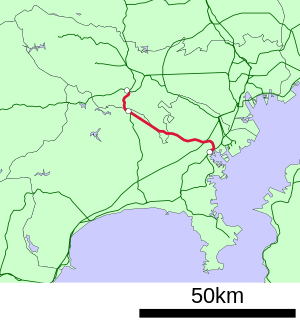Yokohama Line
This article needs additional citations for verification. (January 2010) |
| Yokohama Line | |||
|---|---|---|---|
| JH | |||
 A Yokohama Line E233-6000 series EMU | |||
| Overview | |||
| Native name | 横浜線 | ||
| Locale | Kanagawa Prefecture, Tokyo | ||
| Termini | |||
| Stations | 20 | ||
| Service | |||
| Type | Heavy rail | ||
| Operator(s) | JR East | ||
| Rolling stock | E233-6000 series | ||
| Daily ridership | 840,200 (daily 2015)[1] | ||
| History | |||
| Opened | 1908 | ||
| Technical | |||
| Line length | 42.6 km (26.5 mi) | ||
| Track gauge | 1,067 mm (3 ft 6 in) | ||
| Electrification | 1,500 V DC overhead catenary | ||
| Operating speed | 95 km/h (59 mph) | ||
| |||
Yokohama Line | |||||||||||||||||||||||||||||||||||||||||||||||||||||||||||||||||||||||||||||||||||||||||||||||||||||||||||||||||||||||||||||||||||||||||||||||||||||||||||||||||||||||||||||||||||||||||||||||||||||||||||||||||||||||||||||||||||||||||||||||||||||||||||||||||||||||||||||||||||||||||||||||||||||||||||||||||||||||||||
|---|---|---|---|---|---|---|---|---|---|---|---|---|---|---|---|---|---|---|---|---|---|---|---|---|---|---|---|---|---|---|---|---|---|---|---|---|---|---|---|---|---|---|---|---|---|---|---|---|---|---|---|---|---|---|---|---|---|---|---|---|---|---|---|---|---|---|---|---|---|---|---|---|---|---|---|---|---|---|---|---|---|---|---|---|---|---|---|---|---|---|---|---|---|---|---|---|---|---|---|---|---|---|---|---|---|---|---|---|---|---|---|---|---|---|---|---|---|---|---|---|---|---|---|---|---|---|---|---|---|---|---|---|---|---|---|---|---|---|---|---|---|---|---|---|---|---|---|---|---|---|---|---|---|---|---|---|---|---|---|---|---|---|---|---|---|---|---|---|---|---|---|---|---|---|---|---|---|---|---|---|---|---|---|---|---|---|---|---|---|---|---|---|---|---|---|---|---|---|---|---|---|---|---|---|---|---|---|---|---|---|---|---|---|---|---|---|---|---|---|---|---|---|---|---|---|---|---|---|---|---|---|---|---|---|---|---|---|---|---|---|---|---|---|---|---|---|---|---|---|---|---|---|---|---|---|---|---|---|---|---|---|---|---|---|---|---|---|---|---|---|---|---|---|---|---|---|---|---|---|---|---|---|---|---|---|---|---|---|---|---|---|---|---|---|---|---|---|---|---|---|---|---|---|---|---|---|---|---|---|---|---|---|---|---|---|
| |||||||||||||||||||||||||||||||||||||||||||||||||||||||||||||||||||||||||||||||||||||||||||||||||||||||||||||||||||||||||||||||||||||||||||||||||||||||||||||||||||||||||||||||||||||||||||||||||||||||||||||||||||||||||||||||||||||||||||||||||||||||||||||||||||||||||||||||||||||||||||||||||||||||||||||||||||||||||||
The Yokohama Line (Japanese: 横浜線, romanized: Yokohama-sen) is a Japanese railway line of the East Japan Railway Company (JR East) connecting Higashi-Kanagawa Station in Yokohama, Kanagawa and Hachiōji Station in Hachiōji, Tokyo. The line forms part of what JR East refers to as the "Tokyo Mega Loop" (Japanese: 東京メガループ) around Tokyo, consisting of the Keiyo Line, Musashino Line, Nambu Line, and Yokohama Line.[2] The line's name comes from the section between Nagatsuta and Higashi-Kanagawa that runs through the city of Yokohama. Nicknamed the Hama-sen (浜線) by locals,[3] the line serves commuters in the southwestern suburbs of Tokyo and northeastern suburbs of Yokohama.
History[edit]

The line was opened by the private Yokohama Railway (横浜鉄道, Yokohama Tetsudō) on 23 September 1908 and leased to the government in 1910.[4] The line was nationalized on 1 October 1917.[4]
The Higashi-Kanagawa to Haramachida (now Machida) section was electrified on 1 October 1932, with the Haramachida to Hachiōji section electrified on 14 April 1941.[4]
The Higashi-Kanagawa to Kozukue section was double-tracked by 1968, extended to Aihara by 1980, and completed to Hachiōji on 6 March 1988.[4]
Through service trains from the Sagami Line began on 16 March 1991, when that line was fully electrified.
Station numbering was introduced on 20 August 2016 with stations being assigned station numbers between JH13 and JH32.[5][6] Numbers increase towards in the westbound direction towards Hachioji.
Through service operation from the Sagami Line onto the Yokohama Line ended on 11 March 2022.[7]
Operation[edit]
Despite the line's name, only approximately half of all trains run as far as Yokohama Station. Rapid (快速, Kaisoku) trains operate every 20 minutes during the daytime.
Stations[edit]
- Local trains stop at all stations.
- Information on the limited express Hama Kaiji service can be found on its page.
- Rapid trains stop at stations marked "●" and pass those marked "|".
- From Yokohama to Ofuna, the stations are the same stations served by the Negishi Line.
Rolling stock[edit]
This section may require cleanup to meet Wikipedia's quality standards. The specific problem is: Images are cluttered. (January 2023) |
Local and Rapid services

- E233-6000 series 8-car EMUs (since February 2014)[8]
Former[edit]
-
72 series EMU, July 1984
-
103 series EMU at Fuchinobe Station, circa 1988
-
A Yokohama Line 205 series EMU, March 2007
-
Sagami Line 205-500 series EMU, November 2021
-
Sagami Line E131-500 series EMU, November 2021
- 72 series
- 103 series (from 2 October 1972 until 26 February 1989)
- 205 series 8-car EMUs (1988 to August 2014)
Sagami Line through services
- 205-500 series 4-car EMUs (from 16 March 1991 until 25 February 2022)[9]
- E131-500 series 4-car EMUs (from 18 November 2021 until 11 March 2022)[10]
8-car 205 series EMU trains were introduced in 1988.[11] In these sets, the second car from the Higashi-Kanagawa end had six pairs of doors on each side to allow rapid boarding and disembarking during peak periods. The last 205 series set on the Yokohama Line ran on 23 August 2014.[12]
References[edit]
- ^ "平成27年 大都市交通センサス 首都圏報告書" (PDF). P.92. 国土交通省.
- ^ Saka, Masayuki (August 2014). 東京メガループ 車両・路線の沿革と現況 [Tokyo Megaloop: History and current situation of trains and line]. Tetsudō Daiya Jōhō Magazine (in Japanese). Vol. 43, no. 364. Japan: Kōtsū Shimbun. pp. 28–39.
- ^ Aizawa, Masao (1996). Hamasen chimei arekore yokohama-hen. 230 Club Shinbunsha. ISBN 978-4-931353-24-4.
- ^ a b c d "横浜線開業100周年~その2: 開業から現在までの他線との接続の歴史". Japan Railfan Magazine. Vol. 49, no. 574. February 2009. pp. 98–99.
- ^ "⾸都圏エリアへ 「駅ナンバリング」を導⼊します" [Introduce “station numbering” to the Tokyo metropolitan area] (PDF). jreast.co.jp (in Japanese). 6 April 2016. Archived from the original (PDF) on 7 December 2022. Retrieved 7 January 2023.
- ^ Kusamachi, Yoshikazu (7 April 2016). "JA・JK・JT・AKB…JR東日本、首都圏で駅ナンバリングなど導入へ" [JA, JK, JT, AKB … JR East to introduce station numbering in the Tokyo metropolitan area]. Response Automotive Media (in Japanese). Archived from the original on 6 August 2022. Retrieved 7 January 2023.
- ^ "2022年3月ダイヤ改正について(八王子支社)" [March 2022 timetable revision, Hachioji Branch] (PDF) (in Japanese). 17 December 2021. Archived (PDF) from the original on 11 March 2022. Retrieved 15 March 2022.
- ^ "E233系6000番台が営業運転を開始" [E233-6000 series enter revenue service]. Japan Railfan Magazine (in Japanese). Japan: Koyusha Co., Ltd. 17 February 2014. Archived from the original on 3 October 2016. Retrieved 17 February 2014.
- ^ "横浜線開業100周年~その1: バトンタッチしてきた車両たち". Japan Railfan Magazine. Vol. 49, no. 574. February 2009. pp. 94–97.
- ^ "相模線E131 系営業運転開始について" [About the entry of service of the Sagami Line E131 series] (PDF). Japan Railfan Magazine Online (in Japanese). 17 September 2021. Archived (PDF) from the original on 20 November 2021. Retrieved 15 March 2022.
- ^ "JR東日本 横浜線にE233系6000番代を投入" [JR East to introduce E233-6000 series on Yokohama Line]. Tetsudō Daiya Jōhō Magazine (in Japanese). Vol. 42, no. 356. Japan: Kōtsū Shimbun. December 2013. p. 60.
- ^ "横浜線用の205系が営業運転を終了" [End of 205 series revenue operations on Yokohama Line]. Japan Railfan Magazine Online (in Japanese). Japan: Koyusha Co., Ltd. 24 August 2014. Archived from the original on 15 April 2021. Retrieved 15 March 2022.






